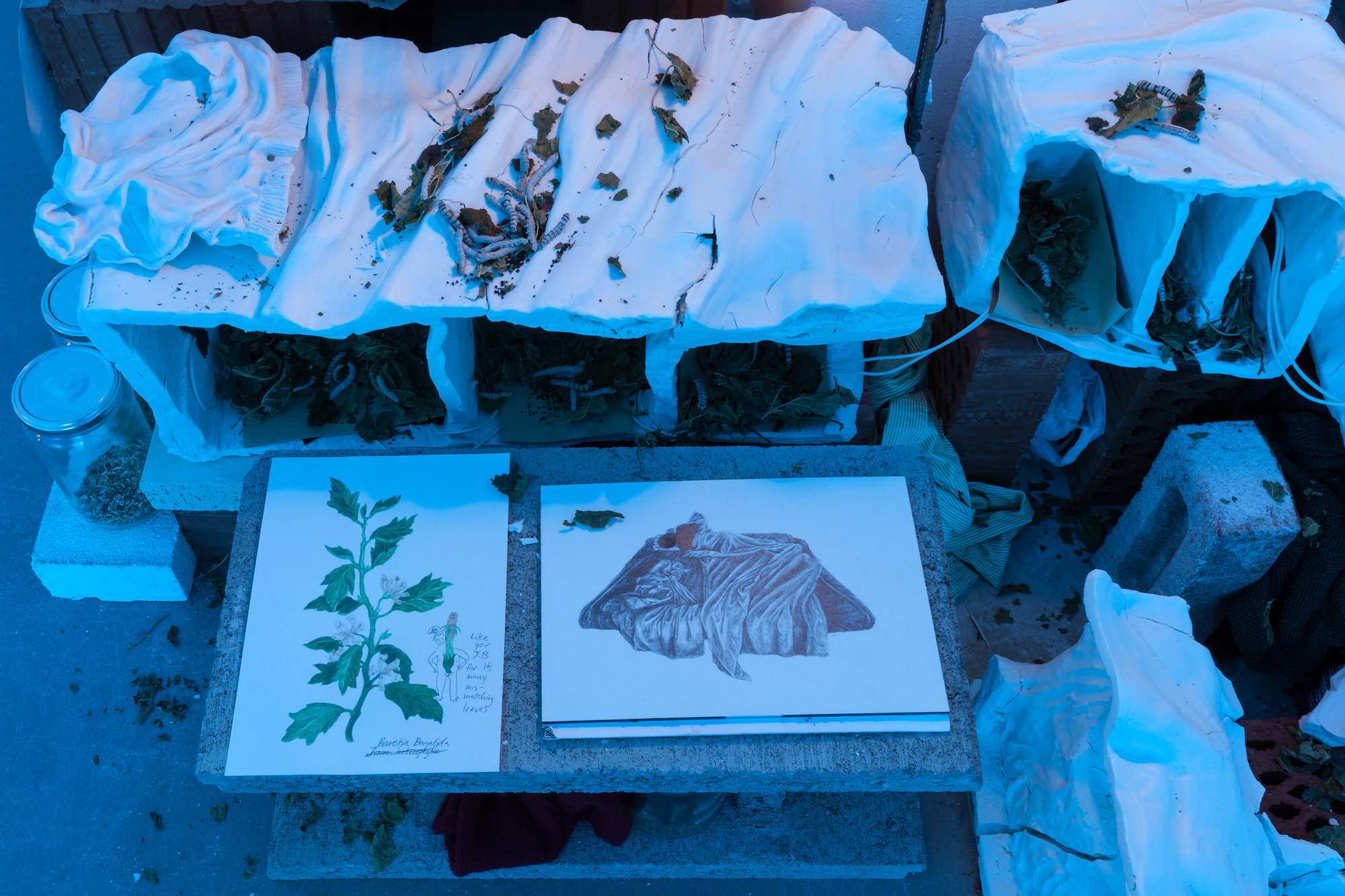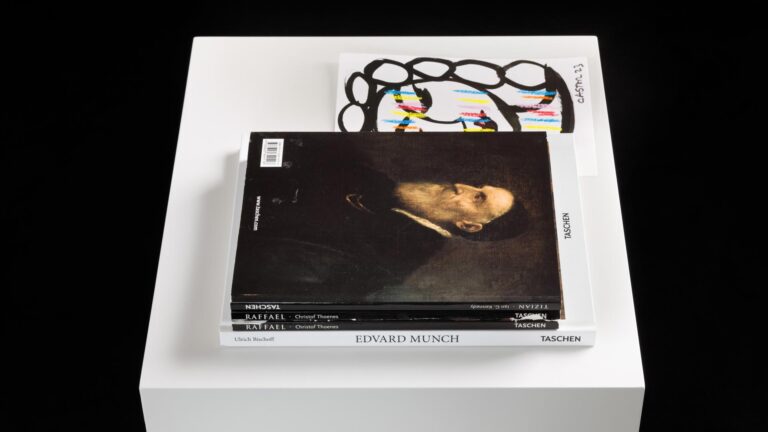Artist: Candice Lin
Exhibition title: A Hard White Body, a Soft White Worm
Curated by: Lotte Arndt, Lucas Morin and Philippe Pirotte
Venue: Portikus, Frankfurt, Germany
Date: February 10 – April 8, 2018
Photography: all images copyright and courtesy of the artist and Portikus, Frankfurt, Photo: Helena Schlichting
Note: Exhibition booklet can be found here
Portikus is pleased to announce the exhibition A Hard White Body, a Soft White Worm by American artist Candice Lin – her first institutional solo exhibition in Germany. Lin’s exhibition invites viewers into a fragmented environment of broken porcelain. Elements of drapery, clothing, and discarded books are the remnants of a preceding form presented in Paris: a fragile room sculpted entirely of unfired porcelain, moist – alive with green moss and orange fungi. The new scene at Portikus testifies to irrecoverable loss, of desolation and absence, of a life – always tenuous – now gathered together in pieces that do not comprise the whole. But in the scattered and dispersed fragments, precarious lives become visible in glimpses, and a diasporic longing for a portable home creates new genealogies by affinity.
Lin weaves together the stories of James Baldwin (1924–1987), black American novelist and essayist, Jeanne Baret (1740–1807), French botanist and first woman to have sailed around the globe, and Maria Sibylla Merian (1647-1717), artist and naturalist born in Frankfurt. Going beyond their highly divergent social situations and historical contexts, Lin highlights how all three characters engaged throughout their lives and work in complex negotiations of intersectional power relations. Strongly engaged in the Civil Rights movement, James Baldwin was nevertheless dismissed by some of the Black Panther Party leaders for his homosexuality, which they disparaged by aligning it with femininity and whiteness. In his novel Giovanni’s Room (1956), Baldwin describes a makeshift home, a space that is both oppressive and hopeful, impoverished yet constantly being renovated. This description of Giovanni’s room was the inspiration for Lin’s preceding iteration of the room rendered in wet porcelain; it is the site that makes possible a desire, rich, but still evocative of internalized self-loathing. Here, in preserved fragments, it represents the way stories are recomposed in incomplete and new arrangements.
Jeanne Baret left her peasant life by means of a borrowed identity: She cross-dressed as a man to be able to embark aboard the French ship L’Étoile for the famous voyage navigated by Louis-Antoine de Bougainville in 1766. Visible only through scarce archival traces and minor reports written by distant commentators, Baret’s outstanding trajectory is overshadowed by the legacy of the royal botanist Philibert Commerson, her lover and employer. In his journals, his debt to Baret’s knowledge is apparent in references to plants he learned from her alongside racialized and classed descriptions of her masculinity.
Unlike Baret, Maria Sibylla Merian grew up in an environment of renowned engravers and printmakers (including her step-grandfather Theodore de Bry, who made the first publicly disseminated images of the New World shown in Europe). Merian had an exceptional life as a woman and a scientist of her time. She left her native Frankfurt to spend most of her life in the Netherlands, living for some time under the protection of the religious community of the Labadists, divorced and in custody of her two daughters. In her fifties, she traveled for two years to Suriname, pursuing her research on metamorphosis. Though ostensibly complicit with colonialism and slavery in the Dutch colony, she was one of the few to credit African and Indigenous slaves and workers, on whose labor she relied.
In the speculative narrative of Candice Lin’s exhibition A Hard White Body, a Soft White Worm at Portikus, the three human characters encounter non-human agents. The sculptures are made of porcelain, a material that has been described in a racially anxious language as an exquisite white body, a Chinese secret of Western desire, inimitable until the mid-eighteenth century. While porcelain is known for its pure whiteness and resistance to cracking or staining, here, its damaged aspect reveals its fragility and porosity. In the nineteenth century the French scientists Louis Pasteur and Charles Chamberland used it as a filter for the study of bacteria. In doing so, they discovered the existence of viruses as well as the local cause of the 1865 silkworm disease, which caused large economic losses in the French countryside and was spoken of as a foreign contamination. A century and a half earlier, Maria Sybilla Merian had extensively searched for a profitable New World equivalent to the silkworm.
Alongside the installation, a detox herbal tea is boiling, welcoming the visitors for a hot drink. The plants in the brew are the components of Swiss Tea, marketed by Commerson from the plants he learned about from Baret. The tea evokes an idea of a healthy, natural body that is cleansed from damaging environmental and social influences, such as toxic working conditions, or endocrine disruptors. The privilege of purity is linked to race and class, and aligned with heteronormative reproductive sexuality; it is upheld by racializing language throughout the centuries and obscures the unequal exposure to toxicity. The hot tea is prepared in the exhibition and visitors can serve themselves; an invitation that brings about the question of individual purity in toxic times.
A Hard White Body, a Soft White Worm is a coproduction with Bétonsalon – Center for Art and Research, Paris and the Reva and David Logan Center for the Arts, The University of Chicago, with contribution from Temporary Gallery, Cologne.
The exhibition at Portikus was made possible with the financial support of the Hessische Kulturstiftung.
Candice Lin, A Hard White Body, a Soft White Worm, 2018, exhibition view, Portikus, Frankfurt
Candice Lin, A Hard White Body, a Soft White Worm, 2018, exhibition view, Portikus, Frankfurt
Candice Lin, A Hard White Body, a Soft White Worm, 2018, exhibition view, Portikus, Frankfurt0
Candice Lin, A Hard White Body, a Soft White Worm, 2018, exhibition view, Portikus, Frankfurt
Candice Lin, A Hard White Body, a Soft White Worm, 2018, exhibition view, Portikus, Frankfurt
Candice Lin, A Hard White Body, a Soft White Worm, 2018, exhibition view, Portikus, Frankfurt
Candice Lin, A Hard White Body, a Soft White Worm, 2018, exhibition view, Portikus, Frankfurt
Candice Lin, A Hard White Body, a Soft White Worm, 2018, exhibition view, Portikus, Frankfurt
Candice Lin, A Hard White Body, a Soft White Worm, 2018, exhibition view, Portikus, Frankfurt















